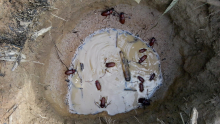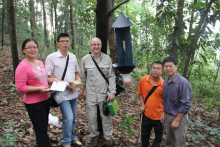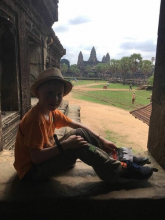Your Research. Your Life. Your Story.
A magnetic community of researchers bound by their stories
Every researcher has a story. What’s yours?
A blacklight, some starlight, and a great many sleepless nights

Field Research. It’s romanticized. It stirs emotions of excitement and opportunity. At university, like all ordinary biology majors, we learned of Charles Darwin’s “Voyage of the Beagle” and how his visit to the Galapagos Islands, his meticulous collections and observations of tortoises and finches and other uniquely adapted wildlife, contributed to this thinking on the origin of species. Later, he famously revolutionized the field of evolutionary biology with his groundbreaking theory of natural selection when he published “Origin of Species.” At the same time, Alfred Russel Wallace tromped through rainforests in South America and then the Malay Archipelago collecting myriads of birds, beetles, butterflies, and other animals and plants, and he discovered the “Wallace Line” between Bali and Lombok, which separates the faunas of Asia and Australia. He, too, arrived at the same conclusion as Darwin, and they jointly published works on the theory of evolution by natural selection in 1858. Mesmerized by these groundbreaking works, I was ready to go my own adventure.
My junior year, opportunity struck. Dr. Kenneth Mantai, the botany professor at the State University of New York at Fredonia, offered a field biology course on Tropical Biology in the fall semester, which culminated in a 19-day field trip to Costa Rica during the semester break in January. The summer before, I worked 3 jobs to exhaustion to pay for the trip: I worked an early-morning shift as a summer cleaner at my old high school, refereed football in the afternoon, then worked a late shift at a restaurant as a bus boy clearing tables. I slept only a few hours a night, but when classes began that fall, I managed make enough to register for the course and pay for the trip that changed my life forever.
The first place we visited was Cano Palma Biological Station, a Canadian-run field station deep in the Atlantic lowland rainforests near the village of Tortuguero, which can only be accessed by a 4-hour boat journey. The station was situated on a black water canal, with water very clean and appearing black from the tannins leached from rainforest leaves. It was only 100 meters from the Caribbean coast and the most important Green Sea Turtle nesting grounds in the western hemisphere, so it was paradise for a budding biologist. I fell in love with the tropical rainforest, and I knew I wanted to be an ecologist.
The following summer, I took another Tropical Field Ecology course in Costa Rica with my mother, who is also a biologist, and then my dreams came true when I returned to the Cano Palma Biological Station as an intern for the 5 months of the final semester of my senior year. I spent a field season characterizing the biodiversity of tropical hawkmoths. The moths were nocturnal, so my project required me to stay up nights, but the days were too hot and humid to sleep, plus I had to lead tour groups in the rainforest to earn donations to support the station. My hobby of butterfly-collecting kept me awake the rest of the day, so I don’t think I slept for 5 months! At university, just before the trip, when someone asked me if I was ready for the rainforest, Dr. Mantai quipped, knowing how ready I was, “Is the rainforest ready for Jake?”
Field Research is hard. Getting research permits can be even harder. In Costa Rica, it required a proposal to be submitted in Spanish to the Costa Rica Ministry of Environment and Energy (MINAE) office. I made two collections of moths: one voucher collection to donate to the University of Costa Rica, and another to take home with me under permit that allowed me to export 5 specimens for every species that I donated to the museum. Some nights required me to hike up an extinct volcano, known locally as the “cerro,” which was only 80 m high but nonetheless a hard climb. This was because I had to carry with me with my UV light “blacklight,” a white sheet to attract moths (they navigate by starlight and are “attracted” to UV lights), a tent, a backpack, a Honda generator, and 4 liters of fuel to power my “blacklighting” equipment. Mosquitos were plentiful, and in my tent, I had to contend with bullet ants: giant 3-cm-long ants with a sting so powerful it feels like getting hit by a bullet.
When you are doing something you love, you forget about the minor inconveniences and sleep deprivation, and the long hours spent collecting data pass by quickly. I returned the following year to Cano Palma as a master’s student. I completed the research project by conducting a structured biodiversity survey of the hawkmoths and then went home to write my master’s thesis.
Field research as a Ph.D. researcher in chemical ecology was a different affair. Chemical ecology is the study of how animals communicate using pheromones and kairomones—volatile chemical substances they release, which travel through the air to members of the same species. I had to do 5 years of intense lab work at the State University of New York College of Environmental Science and Forestry in Syracuse, New York, before I saw my first field season. My research revolved around the Asian Longhorned Beetle, an invasive species introduced to the United States from China that kills many species of trees with their woodboring larvae. The only way to survey for them at the time is to hire smokejumpers to climb and inspect trees for exit holes near the tree crown and egg-laying marks from female beetles on the trunks. My research goal was to identify pheromones for the beetle that could be used in traps for surveying and monitoring. I was now the opposite of a field researcher; I was a “lab rat.”

Field research took me to Ningxia, China, to test pheromone lures. It was rewarding (and a sigh of relief!) to simply be at this stage of my research because I could finally test and gather conclusive proof that I’d correctly characterized the activity of the pheromone compounds I had identified, synthesized, and painstakingly formulated into lures. Now, field research was nerve-wracking. I had spent 5 years of my life on this project, traveled halfway around the earth, and had no idea if the project would work. My Ph.D. degree depended on success.

Jacob in Guangxi
I was also in a foreign country and was experiencing cultural and language differences. I spent three summers in China, during which I collected enough beetles to write up all the work in my dissertation. I received two National Science Foundation (NSF) grants and completed my Ph.D. After that, I started an NSF International Research Fellowship Program in Beijing, China, that was supposed to last 2 years, and I ended up staying for 12 years, got married, and now have an 11-year-old son. And yes, during this time, I did field research projects in Yunnan, Guangxi, Heilongjiang, Anhui, and many other provinces and taught field courses for M.S. and Ph.D. students all over Southeast Asia.
Field research is still hard, but in other ways. As an established researcher, journal editor, husband, and father, the main challenge is getting time to go the field and finding the work–life balance so that I can spend time with my family. One way I’ve tried to address this challenge is to take my son with me on my field visits. He is growing up helping me trap beetles all over China and Southeast Asia!

Jacob's son, Misha, in Angkor Wat
Comments
You're looking to give wings to your academic career and publication journey. We like that!
Why don't we give you complete access! Create a free account and get unlimited access to all resources & a vibrant researcher community.

Your Research. Your Life. Your Story.
A magnetic community of researchers bound by their stories






